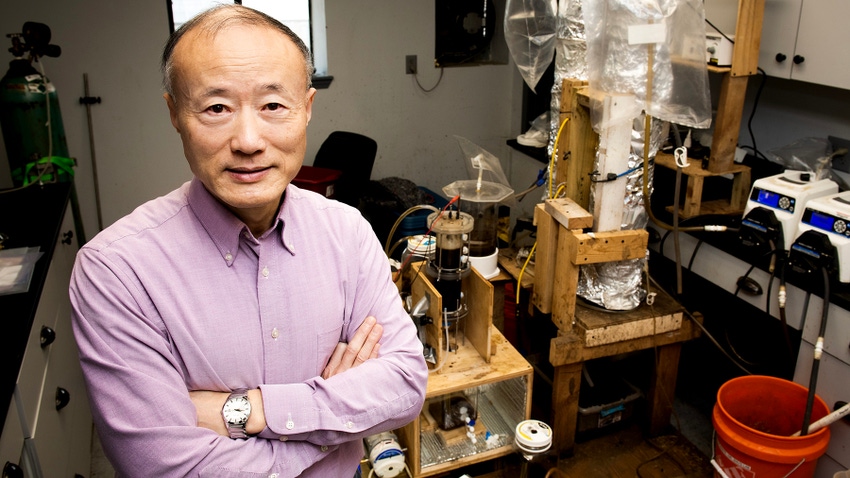May 11, 2023

At a Glance
- Struvite, a slow-release phosphorus fertilizer, created in electrolytic reactor.
- Water purified by forward osmosis and returned to liquid-state digester.
- About half a gram of struvite created per liter of chicken litter solution.
By John Lovett, University of Arkansas System Division of Agriculture
Arkansas Agricultural Experiment Station researchers have assembled a novel prototype system that could help alleviate the issue of excess nutrient runoff in watersheds from poultry litter.
The system turns chicken litter into a more biologically stable fertilizer called struvite, captures methane and recycles most of the water it uses. It is the first system of its kind in the United States, according to Jun Zhu, director of the Center for Agricultural and Rural Sustainability.
“Over the years, techniques to treat poultry litter have been researched extensively, including composting, direct combustion, pelletization, and anaerobic digestion,” said Zhu professor of biological and agricultural engineering at the experiment station, the research arm of the University of Arkansas System Division of Agriculture. “However, none of these technologies are found to be economically or environmentally friendly in the real world.”

Yiting Xiao, a Ph.D. candidate in biological and agricultural engineering, demonstrates the operation of a poultry litter digester designed to reduce the liquid content and solid bulk of poultry litter. (Fred Miller)
Anaerobic digestion, decomposition of solids by microorganisms in the absence of oxygen, is the best of the current techniques, Zhu said. But that is a process that works best with liquids, and poultry litter has a very low moisture content. Zhu and his team developed a system that recycles the water needed for anaerobic digestion while creating struvite from the excess nutrients in chicken litter.
Land-grant partners
In December, two other land-grant university partners — the University of Idaho and Virginia Tech — built the three-piece system at the experiment station. The project is partly funded by U.S. Department of Agriculture’s National Institute of Food and Agriculture and the Agriculture and Food Research Initiative’s Foundational and Applied Science Program.
In addition to turning chicken litter into a more biologically stable product, the system can help support a poultry farmer’s energy demands by capturing methane from anaerobic digestion. Zhu said the methane can be used as a heating and cooking fuel.

Yuanhang Zhan explains the three phases of the liquid-state poultry litter digester designed to reduce the liquid content to a slow-release fertilizer called struvite. (Fred Miller)
Struvite is considered an eco-friendly fertilizer because only a small percentage is water soluble, and struvite releases its nutrients slowly. A two-year experiment station field study in east Arkansas by Kris Brye, University Professor of applied soil physics and pedology, showed struvite performed just as well, and in some cases better, as mined phosphate on corn, soybeans and rice. Mined phosphate is a finite resource prone to price fluctuations.
Another benefit of anaerobic digestion on poultry litter, Zhu explains, is that it removes nuisance odors. Poultry production in Arkansas generates about 1.5 million tons of manure every year. The fast growth of the poultry industry in northwest Arkansas resulted in a significant increase in litter production, which led to local disposal issues. Poultry litter contains nutrients from chicken feces and bedding material such as straw, sawdust, wood shavings, shredded paper, and peanut or rice hulls.
How it works
Yuanhang Zhan, a Ph.D. candidate in Zhu's lab, has optimized the carbon-nitrogen ratios for chicken litter and wheat straw in the poultry litter digestion phase to produce an expected amount of methane. Researchers chose wheat straw because of its common use as a winter crop in Arkansas.
After capturing the biogas from the digestion chamber, the system’s second phase is to use a lightly electrically charged magnesium plate in an electrolytic reactor to separate nutrients from the liquid and drop into a settling tank as struvite. Depending on the amount of phosphate and ammonium in the 1-liter mixture, about 1 gram of magnesium ammonium phosphate struvite precipitates and then is dried to form a powder.
Zhu said the electrolytic reactor was built by collaborates at the University of Idaho led by Sarah Wu to prevent water electrolysis, so no hydrogen gas is produced.
With the struvite in the settling tank, the remaining effluent is cleaned by a final forward osmosis system built by collaborators at Virginia Tech, led by Zhiwu Wang.
Forward osmosis is a water separation process that uses a semipermeable membrane and the natural energy of osmotic pressure to separate water from solids in the solution. Peristaltic pumps transfer the clean water back into the digester designed and built at the experiment station.
While most of the nutrients are precipitated by the electrolytic reactor, and between 80 and 90 percent of the water comes out clear, there is a small amount of “rejected” water created that also contains a small amount of nutrients. Zhu said his collaborators at Virginia Tech have mentioned the rejected water could be used as a road treatment for ice and snow prevention in the wintertime.
Zhu expects an upscaled system to be used at an experiment station broiler house for further tests.
Other collaborators on the liquid-state poultry digester have included Amanda Ashworth with the USDA Agricultural Research Service, and the following University of Arkansas faculty: the late Sammy Sadaka, associate professor and extension engineer; Thomas Costello, associate professor of biological and agricultural engineering; Wen Zhang, associate professor of civil engineering; and Mike Popp, professor of agricultural economics and agribusiness. Yiting Xiao, a Ph.D. student in Zhu’s lab, has also been involved with the project.
Source: University of Arkansas System Division of Agriculture
You May Also Like




